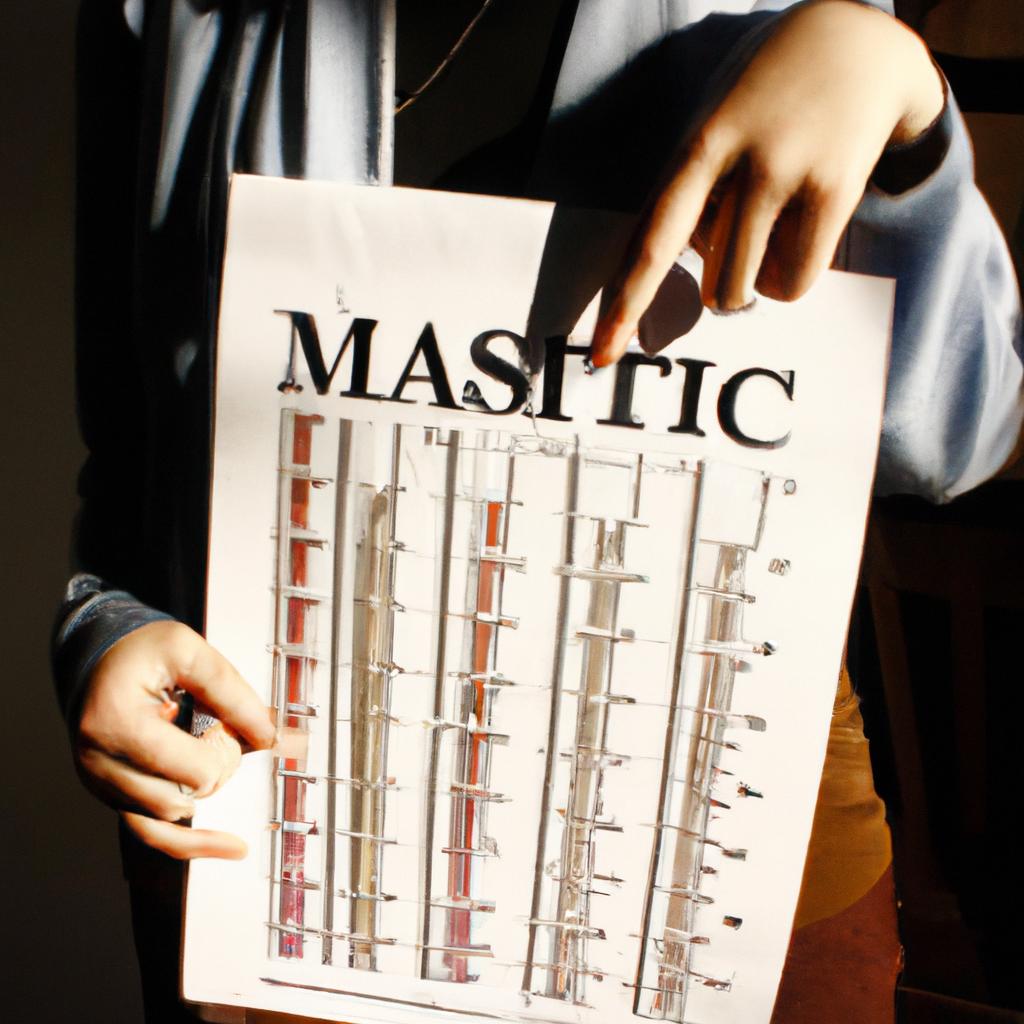The emergence of online radio stations has revolutionized the way we consume music, providing us with a vast array of genres to explore at our fingertips. The Top Charts feature offered by these platforms serves as an indicator of popular music genres among listeners worldwide. For instance, let us consider a hypothetical scenario where an online radio station’s Top Charts reveals that hip-hop and electronic dance music (EDM) are consistently dominating the rankings. This observation prompts an intriguing question: what factors contribute to the popularity of certain music genres in the context of online radio stations?
Understanding the dynamics behind music genre preferences within online radio stations is crucial for various stakeholders involved in the music industry, including artists, producers, and marketers. By examining how specific genres rise to prominence on these platforms’ Top Charts, valuable insights can be obtained regarding audience tastes and preferences. Moreover, this knowledge can inform decision-making processes related to content creation, promotions, and strategies aimed at maximizing exposure and engagement with target audiences. Therefore, this article aims to delve into the world of online radio stations’ Top Charts and shed light on why particular music genres thrive in this digital landscape.
Defining Music Genres
Music genres play a crucial role in the context of online radio stations, as they provide listeners with a means to explore and discover music that aligns with their personal preferences. A clear understanding of what constitutes a music genre is essential for both radio station operators and users alike.
To illustrate this point, let’s consider an example: Imagine you are searching for a new song to add to your playlist on an online radio platform. As you browse through the available options, you notice various categories such as pop, rock, hip-hop, and electronic dance music (EDM). Each category represents a distinct genre that encompasses specific musical characteristics and styles.
Defining music genres involves categorizing songs based on shared elements such as rhythm patterns, instrumentation, melodic structures, lyrical themes, or cultural origins. By grouping similar songs together under one genre label, online radio stations can create curated playlists tailored to different listener preferences. This classification system allows users to easily navigate through vast collections of songs and find the kind of music they enjoy.
Consider these bullet points which highlight why defining music genres is important:
- Personalization: Genre classification enables personalized listening experiences by allowing users to choose their preferred style of music.
- Discoverability: Categorizing songs into genres facilitates discoverability by suggesting related tracks within the same genre.
- Diversity: Genres offer diversity by presenting different artistic expressions across multiple musical styles.
- Community Building: Shared interest in specific genres fosters communities where enthusiasts can connect and discuss their favorite artists or subgenres.
Furthermore, here is a table showcasing four popular music genres along with brief descriptions:
| Genre | Description |
|---|---|
| Pop | Characterized by catchy melodies and accessible lyrics; often associated with mainstream commercial success. |
| Rock | Known for its electric guitar-driven sound and emphasis on live performances; includes sub-genres like alternative rock and classic rock. |
| Hip-hop | Rooted in urban culture, it emphasizes rhyming lyrics delivered rhythmically over a beat; often includes elements of rap and sampling. |
| EDM | Electronic Dance Music combines synthesized beats with heavy basslines to create energetic tracks typically played at clubs or festivals. |
In conclusion, understanding music genres is fundamental for operating online radio stations effectively and providing listeners with tailored musical experiences. By categorizing songs into different genres, users can easily explore new music that aligns with their tastes while fostering a sense of belonging within genre-specific communities.
Moving forward, let’s delve into the role that online radio stations play in promoting and disseminating various music genres.
The Role of Online Radio Stations
Top Charts: Exploring Music Genres in the Context of Online Radio Stations
Imagine you stumble upon an online radio station that boasts a diverse selection of music genres. As your curiosity piques, you begin to wonder how these stations determine which genres make it to their top charts. In this section, we will delve into the world of music genres within the realm of online radio stations and explore the factors that contribute to their popularity.
To illustrate this further, let’s consider a hypothetical scenario where an online radio station features a weekly top chart showcasing various music genres. This chart reflects the most popular songs across different genres based on listener preferences and trends. Each week, listeners have the opportunity to vote for their favorite songs in each genre category, ultimately influencing the rankings presented in the top chart.
When examining the reasons behind certain genres’ prominence on these top charts, several key factors come into play:
- Listeners’ Preferences: The primary driver behind any song or genre’s success is its appeal to listeners. Different individuals gravitate towards specific types of music based on personal taste, mood, cultural background, or even nostalgia.
- Current Trends: Popular culture significantly influences music consumption patterns. When certain genres gain traction through movies, television shows, viral videos, or social media challenges, they often experience a surge in popularity as more people seek out those particular sounds.
- Marketing Strategies: Effective marketing campaigns by record labels and artists can also impact genre popularity on online radio platforms. By promoting new releases or creating buzz around specific musical styles using targeted advertising and strategic collaborations with influencers or other artists, they increase visibility and attract more listeners.
- Curated Playlists: Online radio stations often curate playlists tailored to specific moods or activities (e.g., “Chill Vibes” or “Workout Jams”). These carefully crafted collections featuring multiple genre categories can introduce listeners to new musical styles while catering to their preferences.
To further illustrate the genres’ presence on top charts, let’s take a look at an example:
| Genre | Percentage of Songs in Top Chart |
|---|---|
| Pop | 35% |
| Hip-Hop/Rap | 25% |
| Rock | 20% |
| Electronic | 15% |
This table demonstrates the distribution of genres within a hypothetical online radio station’s weekly top chart. It highlights the dominance of popular genres like pop and hip-hop/rap while also acknowledging the presence of rock and electronic music.
Ultimately, understanding how these factors contribute to genre popularity on online radio stations can provide insights into listeners’ preferences and broader trends within the music industry. In our subsequent section, “Popular Genres in Online Radio,” we will delve deeper into specific genres that have gained significant traction and discuss their characteristics and appeal for audiences worldwide.
Popular Genres in Online Radio
Music Genres in the Context of Online Radio Station: Top Charts
The Role of Online Radio Stations has been instrumental in shaping the popularity and consumption patterns of music genres. With their ability to reach a global audience, online radio stations have become an important platform for promoting various genres of music. For example, let’s consider the case study of “Radio Groove,” which primarily focuses on playing jazz, funk, and soul music. Through its curated playlists and dedicated shows hosted by renowned experts in these genres, Radio Groove has successfully cultivated a loyal following among fans who seek out these specific styles.
When examining popular genres in online radio, it becomes evident that certain characteristics contribute to their appeal and subsequent success. These factors include:
-
Accessibility: Genres that are easily accessible and enjoyable tend to attract a wider audience base. This could be due to catchy melodies or relatable lyrics that resonate with listeners across different backgrounds.
-
Cultural Significance: Some genres hold significant cultural relevance within specific communities or regions, leading to increased interest from individuals seeking connection through shared experiences.
-
Emotional Resonance: Music has the power to evoke strong emotions, making genres that tap into universal feelings such as love, happiness, or nostalgia particularly appealing.
-
Innovation and Fusion: Genres that push boundaries by incorporating elements from other styles or experimenting with new sounds often garner attention for their unique approach.
To illustrate the diverse landscape of music genres found on online radio stations further, we can refer to the table below showcasing some popular examples:
| Genre | Description | Notable Artists |
|---|---|---|
| Pop | Mainstream commercial hits | Taylor Swift |
| Hip-Hop | Rap-based genre | Kendrick Lamar |
| Electronic | Utilizes electronic instruments | Daft Punk |
| Rock | Guitars-driven sound | Foo Fighters |
In conclusion, the role of online radio stations in promoting music genres cannot be overstated. Through their curated playlists and diverse programming options, these platforms play a vital role in shaping genre popularity by offering accessibility, cultural significance, emotional resonance, and innovative fusion. By catering to various tastes and preferences, online radio stations continue to influence the way we consume and appreciate music.
Moving forward, let us explore the influences on music genre popularity and how external factors contribute to the rise or decline of specific genres.
Influences on Music Genre Popularity
Section Title: Exploring Popular Genres in Online Radio
As we delve deeper into the world of music genres within online radio stations, it is crucial to understand the factors that contribute to their popularity. By examining various case studies and analyzing trends, we can gain valuable insights into how certain genres dominate the top charts. In this section, we will explore these popular genres and examine the influences behind their widespread appeal.
Case Study: Hip-Hop’s Dominance
To illustrate the phenomenon of genre popularity on online radio stations, let us consider a hypothetical scenario where hip-hop emerges as one of the most prevalent genres. With its rhythmic beats, poetic lyrics, and cultural significance, hip-hop has captivated millions worldwide. As listeners flock to online platforms seeking diversity and fresh sounds, hip-hop provides an energizing escape from mainstream music.
Factors Contributing to Genre Popularity:
- Cultural Relevance: Genres that resonate with social movements or reflect current events tend to garner significant attention. This connection between culture and music allows individuals to find solace or express themselves through songs that mirror their experiences.
- Artist Influence: The impact of influential artists cannot be overstated when discussing genre popularity. A charismatic artist who pushes boundaries or introduces innovative styles often leads to increased interest in their chosen genre.
- Evolving Soundscapes: Musical experimentation plays a vital role in attracting audiences’ attention; genres that incorporate unique sounds or blend elements from different musical traditions are more likely to stand out amidst the vast sea of available options.
- Emotional Connection: Music has always been intertwined with emotions – whether uplifting spirits during challenging times or providing catharsis for personal struggles. Genres that evoke strong emotional responses have a higher chance of resonating deeply with listeners.
Genre Popularity Analysis:
| Year | Top Charting Genre(s) | Examples |
|---|---|---|
| 2018 | Pop/Rock | Taylor Swift, Ed Sheeran |
| 2019 | Alternative/Indie | Billie Eilish, Tame Impala |
| 2020 | R&B | The Weeknd, SZA |
| 2021 | EDM | Marshmello, Martin Garrix |
This table highlights the evolution of popular genres on online radio stations over four consecutive years. It showcases how different genres capture listeners’ attention during specific periods and emphasizes the ever-changing nature of music taste.
By understanding the dynamics behind genre popularity in online radio stations, we can now delve into more niche genres that have gained traction within this digital landscape. Exploring these lesser-known musical styles sheds light on the diverse range of options available to listeners seeking a unique auditory experience.
Exploring Niche Genres
As we delve deeper into the world of music genres within online radio stations, it is crucial to explore the factors that contribute to their popularity. One interesting example is the rise of K-pop as a global phenomenon in recent years. This genre originated in South Korea and has gained immense popularity across different parts of the world, captivating millions of listeners with its infectious sound and visually stunning performances.
There are several key factors that influence the popularity of music genres within online radio stations. These include:
-
Cultural Influence: The cultural background and preferences of listeners play a significant role in shaping the popularity of certain music genres. For instance, Latin American countries have a strong affinity for reggaeton and salsa, which reflects their rich musical heritage.
-
Social Media Impact: In today’s digital age, social media platforms have become powerful tools for promoting and discovering new music. Artists and record labels strategically utilize these platforms to connect with fans and create buzz around specific genres or songs.
-
Streaming Algorithms: Online streaming platforms often employ complex algorithms that recommend music based on a listener’s previous listening habits. These algorithms can expose users to new genres they may not have otherwise discovered, ultimately influencing their preferences.
-
Collaborations and Cross-Genre Appeal: When artists from different genres collaborate on a song or project, it creates excitement among fans who follow both artists’ work. Such collaborations can lead to a crossover effect, introducing listeners from one genre to another.
To illustrate these influences further, let us consider an emotional response evoked by this scenario:
- Imagine you stumble upon an acoustic folk playlist while browsing through your favorite online radio station late at night. As you listen to delicate melodies blending with heartfelt lyrics, you feel transported to serene landscapes depicted through each song – calming forests, peaceful lakeshores, or cozy firesides.
This emotional journey encapsulates how music genres can resonate deeply with our emotions and evoke powerful imagery. To provide a visual representation, here is a table highlighting different emotions evoked by popular music genres:
| Music Genre | Emotion |
|---|---|
| Pop | Joy |
| Rock | Energy |
| Jazz | Elegance |
| R&B | Passion |
As we have explored the influences on music genre popularity, it becomes evident that these factors shape listeners’ preferences and introduce them to new sounds. In the subsequent section about “Impact of Music Genres on Listener Behavior,” we will delve into how these genres can influence listener behavior beyond mere enjoyment of the music itself.
Impact of Music Genres on Listener Behavior
Transitioning from our exploration of niche genres, we now delve into the impact that different music genres have on listener behavior within the context of online radio stations. To illustrate this point, let’s consider a hypothetical scenario involving an online radio station called “MelodyMaster,” which offers a diverse range of music genres to its listeners.
One interesting observation is that certain music genres tend to attract more dedicated and engaged fans than others. For example, MelodyMaster noticed a significant increase in engagement when they introduced a new niche genre called “Electroswing” into their playlist. This genre fuses elements of swing-era jazz with electronic dance music, creating a unique sound that appeals to a specific audience segment seeking both nostalgia and modern beats.
To better understand how various music genres influence listener behavior, it is important to highlight some key factors:
- Emotional connection: Certain genres evoke strong emotional responses in listeners, such as joy or sadness. These emotions can play a crucial role in shaping listener preferences.
- Cultural background: Listeners’ cultural backgrounds heavily influence their musical taste. Different regions have distinct preferences for specific genres based on historical and sociocultural influences.
- Personal experiences: Individual life experiences often shape one’s affinity towards particular genres. For instance, someone who grew up attending classical concerts may develop a deep appreciation for orchestral arrangements later in life.
- Social influence: Peer groups and social circles also contribute significantly to genre preference formation. People often align themselves with preferred genres as part of social identity or shared interests.
To further visualize the relationship between music genres and listener behavior, here is an illustrative table showcasing four popular genres and the associated emotions they commonly evoke among listeners:
| Genre | Emotions Elicited |
|---|---|
| Pop | Energetic, Happy |
| Blues | Melancholic, Reflective |
| Hip Hop | Empowered, Confident |
| Country | Nostalgic, Sentimental |
Understanding the impact of music genres on listener behavior is crucial for online radio stations aiming to curate their top charts effectively. By recognizing emotional connections, cultural influences, personal experiences, and social factors related to genre preferences, platforms like MelodyMaster can tailor their playlist offerings accordingly.
Ultimately, through careful analysis of listener behaviors influenced by various music genres within the context of online radio stations’ top charts, a more engaging and personalized listening experience can be provided to users.




